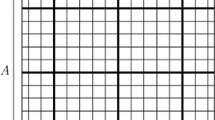Abstract
Under a relatively realistic model, this paper theoretically analyzes the road traffic status inside an urban working field, including its radial roads and circular ones. Concretely, the radial and the circular average traveling distances of a car commuter in a tiny ring with wide dx are first derived, and then the necessary road area, road area rate distributions, the proportion between the radial and the circular roads to be needed are also calculated. The results presented here and the properties shown through the numerical analysis are considered to be significant at the very beginning stage of designing an urban city.
Similar content being viewed by others
References
Akisawa, A., Kaya, Y. Land Use Structure of Minimum Total Trip Length based on Congestion–Free–City Model (in Japanese). The Transactions of the Institute of Electrical Engineers of Japan, 115 (C): 1072–1078
Ito, T. Urban Life and Planning. Gihoudou, Tokyo, 1961 (in Japanese)
Koshizuka, T. The Distances Inside a Region (in Japanese). Journal of the Operations Research Society of Japan, 21: 302–319 (1978)
Li, M.Z. The Average Traveling Distance of a Car Commuter in a Working Area with Radial–Circular Road Network. OR Transactions, 4: 27–31 (2000)
Li, M.Z., Fushimi, M. Some Theoretical Results on the Road Traffic Areas of Circular and Square Working Fields. Proceedings of the Fifth Conference of the Association of Asian–Pacific Operational Research Societies, CD–ROM, 2000
Li, M.Z., Fushimi, M. The SPCP on Two Relaxed Special–Type Networks. Zeitschrift für Angewandte Mathematik und Mechanik, 76(S2): 595–596 (1996)
Okudaira, K. Urban Engineering Analysis. Syogokusya, Tokyo, 1976 (in Japanese)
Oyama, T., Taguchi, A. Further Results on the Shortest Path Counting Problem. Abstracts of the Operations Research Society Fall Meeting. The Operations Research Society of Japan, Tokyo, 1991, 166, 167
Oyama, T., Taguchi, A. On Some Results of the Shortest Path Counting Problem. Abstracts of the Operations Research Society Spring Meeting. The Operations Research Society of Japan, Tokyo, 1991, 102, 103
Taguchi, A. Allocation of Urban Space between Road and Residential Area–Circular City Model of Traffic Congestion Free Area–(in Japanese). Journal of the Operations Research Society of Japan, 38: 398–408 (1995)
Wardrop, J.G. Some Theoretical Aspects of Road Traffic Research. Proceedings of the Institute of Civil Engineers (Part II), Institute of Civil Engineers, London, 1952
Author information
Authors and Affiliations
Corresponding author
Additional information
Partly supported by Grant–in–Aid for Scientific Research of the Ministry of Education, Japan, Grant No.(B)(1)–11380196.
Rights and permissions
About this article
Cite this article
Li, Mz. The Road Traffic Analysis Based on an Urban Traffic Model of the Circular Working Field. Acta Mathematicae Applicatae Sinica, English Series 20, 77–84 (2004). https://doi.org/10.1007/s10255-004-0150-6
Received:
Revised:
Issue Date:
DOI: https://doi.org/10.1007/s10255-004-0150-6




